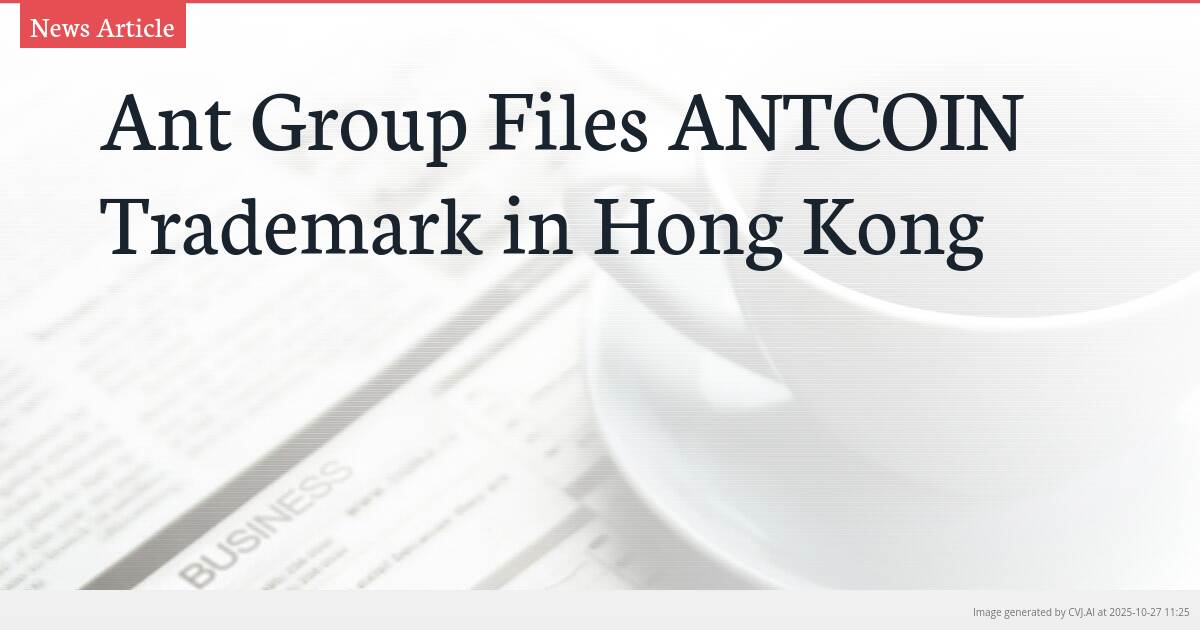This summary text is fully AI-generated and may therefore contain errors or be incomplete.
Introduction
Ant Group, China’s largest internet finance company, has filed to register the ANTCOIN trademark in Hong Kong, covering digital wallets, online payments, and stablecoin services. This strategic move signals the fintech giant’s positioning in Hong Kong’s growing virtual asset sector despite recent regulatory challenges from Beijing that have temporarily stalled its stablecoin ambitions.
Key Points
- The trademark application covers digital wallets, online payments, foreign exchange services, and stablecoin issuance and transfer
- Legal experts warn of risks including fraudulent tokens masquerading as legitimate stablecoins and high-fidelity copycat contracts
- Ant Group recently piloted USDC-based cross-border payments with Circle and launched a blockchain platform to tokenize $8 billion in energy assets
Strategic Trademark Protection in Hong Kong
Ant Group’s trademark application for “ANTCOIN” filed with Hong Kong’s Intellectual Property Department in June represents a comprehensive approach to securing the company’s brand in the digital asset space. The filing covers a broad scope of financial and digital-asset services including online payments, electronic wallets, foreign exchange services, and the issuance and transfer of stablecoins and digital tokens. According to legal experts, this move appears as a strategic effort to protect Ant Group’s interests in Hong Kong’s burgeoning virtual asset sector while the application remains pending before the registry.
Joshua Chu, lawyer, lecturer, and co-chair of the Hong Kong Web3 Association, told Decrypt that the trademark filing represents a “strategic move to protect their interests” in the territory. “Although recent regulatory developments from Beijing have put their stablecoin ambitions on ice, retaining IP rights ensures Ant can defend its brand,” Chu explained. This protective measure comes at a crucial time when Beijing has reportedly ordered major tech firms, including Ant Group, to suspend their stablecoin-related initiatives in Hong Kong.
Navigating Regulatory Challenges and Market Risks
The trademark filing occurs against a backdrop of complex regulatory dynamics between Hong Kong and mainland China. While Hong Kong has been actively developing its virtual asset framework, Beijing has maintained a more cautious stance toward cryptocurrency initiatives. Chu noted that Ant Group’s next moves would depend on how it addresses the “issues which have caused their ambitions to be iced in the first place,” suggesting that regulatory compliance remains the primary hurdle for the company’s stablecoin aspirations.
Legal experts have highlighted significant risks in the stablecoin market that make trademark protection essential. Chu warned about cases “where unauthorized or fraudulent tokens masquerade as USDT” without actually being issued by Tether. He further explained that scammers “have created tokens on various blockchains that use similar names, symbols, or contract addresses” to appear legitimate, while “high-fidelity copycat contracts” can deceive users into believing they hold genuine stablecoins. These operational risks underscore why “trademark protection is a prudent and essential part of risk management” for companies like Ant Group looking to enter Hong Kong’s digital asset market.
Ant Group's Broader Blockchain Strategy
Co-founded by Chinese serial entrepreneur Jack Ma, Ant Group has been steadily advancing its blockchain and digital asset infrastructure as part of its broader shift toward financial technology innovation. The company’s recent initiatives demonstrate a multi-faceted approach to digital assets that extends beyond the ANTCOIN trademark filing. In July, Ant Group collaborated with Circle, a public U.S. company, to pilot USDC-based cross-border payments between Ant International’s Alipay+ network and select global merchants, marking one of the first integrations of a regulated stablecoin into its payment infrastructure.
The company has also been active in dismissing rumors while pursuing substantive blockchain projects. In August, Ant Group clarified that it was not working with China’s central bank on a rare earth-backed RMB stablecoin, addressing speculation about its digital currency initiatives. More recently, in September, its Ant Digital Technologies unit unveiled a blockchain platform designed to tokenize energy assets in China, linking approximately $8 billion worth of infrastructure to on-chain systems. This substantial investment in energy asset tokenization demonstrates Ant Group’s commitment to blockchain technology applications beyond cryptocurrency.
These developments collectively illustrate Ant Group’s strategic positioning in the digital asset ecosystem, balancing innovation with regulatory compliance. While the ANTCOIN trademark represents potential future offerings, the company’s current blockchain initiatives with USDC and energy assets provide tangible examples of its digital transformation strategy. As Hong Kong continues to develop its virtual asset framework, Ant Group’s trademark protection and ongoing blockchain projects position the company to capitalize on emerging opportunities while managing the complex regulatory landscape between mainland China and Hong Kong.
📎 Read the original article on decrypt.co

